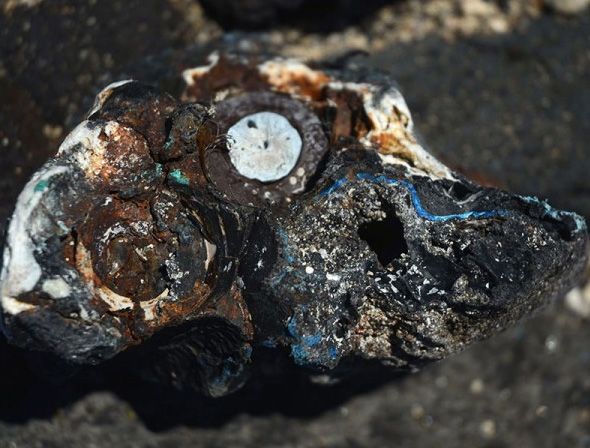Plastic as a Sign of Civilization
We will know the extraterrestrials by their trash.
/https://tf-cmsv2-smithsonianmag-media.s3.amazonaws.com/filer/6e/03/6e03da44-f74d-4e93-9f34-fcb91013da9e/colored_plastic.jpg)
A team of researchers from the U.S. and Canada led by Patricia Corcoran has added a new term to the lexicon of geology: plastiglomerate. On a remote beach on the Hawaiian Big Island, they discovered 167 fragments, ranging in size between 2 centimeters and 22.5 centimeters, of a previously unnamed kind of rock: melted plastic mixed with basalt rocks, sand, wood chips, charcoal and other material. The conglomerate formed when people went to the beach and made fire, which melted plastic that adhered to basalt rocks, sand, coral pieces and other natural objects to form “plastic stones.”

What bearing does this have on the search for extraterrestrial life? Since plastic decays very slowly, it could conceivably be used as a geological marker of a technologically advanced civilization. On Earth, this anthropogenic material has potential as a geological marker for the Anthropocene era, when human activity began to have a significant impact on the environment. Since microbes degrade most plastics very slowly (and some not at all), these plastic rocks on Earth could be preserved for at least 10,000 years, and probably much longer, up to millions of years. How long exactly depends not only on the conditions under which the plastic is buried, but on what type of plastic it is. In certain planetary environments, it is feasible that some plastics could survive billions of years, in which case they could tell us about extraterrestrial civilizations long after they’ve disappeared.
If we were to detect such a geological marker on another planet, it might reveal much about the civilization that left it. The plastiglomerates recovered from the Hawaiian beach include derelict fishing gear such as nets, oyster spacer tubes and buoys; food and drinking containers; resin pellets; and abundant multicolored fragments or “plastic confetti.”
In principal, any compound not found in natural minerals might be useful as a biomarker. Plastics are inert in nearly every type of conceivable life-bearing environment, especially if they are covered by sediments and rocks that protect them from UV irradiation.
The ultimate aim of astrobiology is to find extraterrestrial life that is technologically advanced and is still around. So far, the search for Dyson Spheres has come up empty, and it would be helpful to extend the search space by looking for other types of artifacts from extraterrestrial civilizations. On our own planet, the Anthropocene epoch is only roughly 250 years old, so it’s unlikely that any cultures in our galactic neighborhood would be on the exact same technological level. Maybe, then, we should look for solar systems billions of years older than our own (perhaps around Kapteyn b, for example). And when we do, we might be on the lookout for plastiglomerates.
/https://tf-cmsv2-smithsonianmag-media.s3.amazonaws.com/accounts/headshot/Dirk-Schulze-Makuch-headshot.jpg)
/https://tf-cmsv2-smithsonianmag-media.s3.amazonaws.com/accounts/headshot/Dirk-Schulze-Makuch-headshot.jpg)